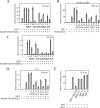A tryptophan-rich motif in the human parainfluenza virus type 2 V protein is critical for the blockade of toll-like receptor 7 (TLR7)- and TLR9-dependent signaling
- PMID: 21345944
- PMCID: PMC3126260
- DOI: 10.1128/JVI.02012-10
A tryptophan-rich motif in the human parainfluenza virus type 2 V protein is critical for the blockade of toll-like receptor 7 (TLR7)- and TLR9-dependent signaling
Abstract
Plasmacytoid dendritic cells (pDCs) do not produce alpha interferon (IFN-α) unless viruses cause a systemic infection or overcome the first-line defense provided by conventional DCs and macrophages. We show here that even paramyxoviruses, whose infections are restricted to the respiratory tract, have a V protein able to prevent Toll-like receptor 7 (TLR7)- and TLR9-dependent IFN-α induction specific to pDCs. Mutational analysis of human parainfluenza virus type 2 demonstrates that the second Trp residue of the Trp-rich motif (Trp-X(3)-Trp-X(9)-Trp) in the C-terminal domain unique to V, a determinant for IRF7 binding, is critical for the blockade of TLR7/9-dependent signaling.
Figures




Similar articles
-
Human parainfluenza virus type 2 V protein inhibits TRAF6-mediated ubiquitination of IRF7 to prevent TLR7- and TLR9-dependent interferon induction.J Virol. 2013 Jul;87(14):7966-76. doi: 10.1128/JVI.03525-12. Epub 2013 May 15. J Virol. 2013. PMID: 23678181 Free PMC article.
-
Human Metapneumovirus M2-2 Protein Acts as a Negative Regulator of Alpha Interferon Production by Plasmacytoid Dendritic Cells.J Virol. 2017 Sep 27;91(20):e00579-17. doi: 10.1128/JVI.00579-17. Print 2017 Oct 15. J Virol. 2017. PMID: 28768858 Free PMC article.
-
An anti-interferon activity shared by paramyxovirus C proteins: inhibition of Toll-like receptor 7/9-dependent alpha interferon induction.FEBS Lett. 2014 Jan 3;588(1):28-34. doi: 10.1016/j.febslet.2013.11.015. Epub 2013 Nov 20. FEBS Lett. 2014. PMID: 24269682
-
Signalling pathways leading to IFN-alpha production in human plasmacytoid dendritic cell and the possible use of agonists or antagonists of TLR7 and TLR9 in clinical indications.J Intern Med. 2009 Jan;265(1):43-57. doi: 10.1111/j.1365-2796.2008.02050.x. J Intern Med. 2009. PMID: 19093959 Review.
-
Impaired Toll-like receptor 7 and 9 signaling: from chronic viral infections to cancer.Trends Immunol. 2010 Oct;31(10):391-7. doi: 10.1016/j.it.2010.07.004. Epub 2010 Sep 9. Trends Immunol. 2010. PMID: 20832362 Review.
Cited by
-
F-actin modulates measles virus cell-cell fusion and assembly by altering the interaction between the matrix protein and the cytoplasmic tail of hemagglutinin.J Virol. 2013 Feb;87(4):1974-84. doi: 10.1128/JVI.02371-12. Epub 2012 Dec 5. J Virol. 2013. PMID: 23221571 Free PMC article.
-
Erythrocyte Binding Activity Displayed by a Selective Group of Plasmodium vivax Tryptophan Rich Antigens Is Inhibited by Patients' Antibodies.PLoS One. 2012;7(12):e50754. doi: 10.1371/journal.pone.0050754. Epub 2012 Dec 6. PLoS One. 2012. PMID: 23236392 Free PMC article.
-
Human parainfluenza virus type 2 V protein inhibits induction of tetherin.Med Microbiol Immunol. 2017 Aug;206(4):311-318. doi: 10.1007/s00430-017-0508-z. Epub 2017 Apr 28. Med Microbiol Immunol. 2017. PMID: 28455649
-
Human parainfluenza virus type 2 V protein inhibits TRAF6-mediated ubiquitination of IRF7 to prevent TLR7- and TLR9-dependent interferon induction.J Virol. 2013 Jul;87(14):7966-76. doi: 10.1128/JVI.03525-12. Epub 2013 May 15. J Virol. 2013. PMID: 23678181 Free PMC article.
-
The intracellular virus-host interface of henipaviruses.J Virol. 2025 Aug 19;99(8):e0077025. doi: 10.1128/jvi.00770-25. Epub 2025 Jul 18. J Virol. 2025. PMID: 40679287 Free PMC article. Review.
References
-
- Cao W., Liu Y. J. 2007. Innate immune functions of plasmacytoid dendritic cells. Curr. Opin. Immunol. 19:24–30 - PubMed
Publication types
MeSH terms
Substances
LinkOut - more resources
Full Text Sources

